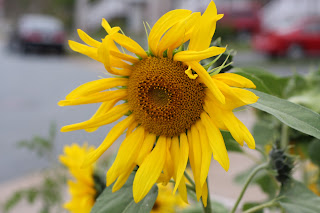Now that things are all tucked away for winter, I have started reading more books. My most recent selection has been less garden specific and more about self-sustaining living. I thought I would share what I've discovered so far. All my links are to abebooks.ca which is an awesome site for finding older (and new) used books from all over the world. I would challenge you to try and find a book that is not listed on that site (essentially a kijiji for used book stores).
Lets go in chronological order:
1) Ten Acres Enough - Edmund Morris (1864)
http://www.abebooks.com/servlet/BookDetailsPL?bi=3126809354&searchurl=an%3Dedmund%2Bmorris%26fromanz%3Dfromanz%26kn%3Dten%26sortby%3D96%26x%3D0%26y%3D0
This was the first book I read. I love history and couldn't wait to sink my teeth into this one. It is essentially one of the first "back to the land" books. A reasonably successful business man in NYC decides that he will buy 10 acres of land in New Jersey and grow peaches, strawberries, raspberries, and blackberries to the big markets in Phillie and NYC. He goes into great deal about his motivations, his wife's reluctance (friends, things to do in the city, kids schooling). He essentially has summarized my motivations for wanting to move to a less "urban" centre and grow my own food, except he lived 150 years ago. Amazing.
This book was initially published annonymously as he thought it might tarnish his reputation to write such a book, contrevening the going sentement of the day. He provides great detail about his life before the move, the move itself (all the $$ details), his neighbors and what happened over a period of about 5 years living on the land. His main message is that you don't need 100 acres to be sucessful, 10 acres is enough.
2) The "have more" plan: A little land, a lot of living. Ed and Carolyn Robinson(1972)
http://www.abebooks.com/servlet/BookDetailsPL?bi=2873256667&searchurl=bi%3D0%26bx%3Doff%26ds%3D30%26kn%3Drobinson%26recentlyadded%3Dall%26sortby%3D17%26tn%3Dhave%2Bmore%2Bplan%26x%3D0%26y%3D0
A step-by-step manual for the small scale homesteader. They argue that you can be self-sufficient on 4 acres of land, and make a small cash income. The book itself is a bit outdated, but it still holds relevant pieces. The Robinson family also left new york, but about 100 years after Edmund, in 1942. They said that new highways and affordable automobiles should allow everyone to own at least an acre outside the city and commute in to work in the city. Well, that was the beginning of suburbia and massive traffic.
Has a 2 page summary on just about everything a homesteader would need to know, even what tools you would need to build your own house!
Another great historical read. Although not something you would read cover to cover, its more of a reference book for the most part.
3) On Good Land - Michael Ableman (1998)
http://www.abebooks.com/servlet/BookDetailsPL?bi=3573085368&searchurl=an%3Dmichael%2Bableman%26bi%3D0%26bx%3Doff%26ds%3D30%26kn%3Dland%26recentlyadded%3Dall%26sortby%3D17%26x%3D0%26y%3D0

The first two pages of this book are aerial photographs of a small town in california. One taken in 1954 and the next in 1998. The first photo shows essentially a town based on agriculture, with farms and orchards from one corner of the photo to the other. The photograph from 1998 shows an area of land that has been absolutely taken over by subdivisions, with one small outlined area which is the lone remaining farm. Michael Ableman lived on this farm and ran its operations for quite a few years. He wrote a book about his experience there, and he also happens to have a keen eye for photography, so the book is full of wonderful pictures. He constantly points out the contradictions in our societies current way of thinking. He, of course, was constantly in court as the neighbors in the subdivisions were suiing him to get rid of his compost piles, chickens, tractors..etc. He always won, but he eventually decided to leave the farm and now lives on his own land in salt spring island, BC, canada. The farm was eventually bought by a community group, and had legal proceedings to protect it, so it will always remain a farm. People driving up in volvo's asking for tomatoes in february for a dinner party were only part of his troubles. A good easy read. I wish he went into more detail, he only seems to brush the surface of most of these issues.
4) Fields of Plenty - Michael Ableman (2005)
http://www.abebooks.com/servlet/BookDetailsPL?bi=3068833721&searchurl=an%3Dmichael%2Bableman%26bi%3D0%26bx%3Doff%26ds%3D30%26kn%3Dland%26recentlyadded%3Dall%26sortby%3D17%26x%3D0%26y%3D0
Another book by Michael Ableman. This is essentially a photo documentary of his 3 month tour of Canada and the USA (mainly), visting various farms. A great overview of different farming philosophies and motivations. My only beef with this book is that he only put in one or two pictures of each farm, I really would have liked to see more!
If you have any suggestions I would love to hear them!
 I have two bunches about this size. Pretty good!
I have two bunches about this size. Pretty good!

















































